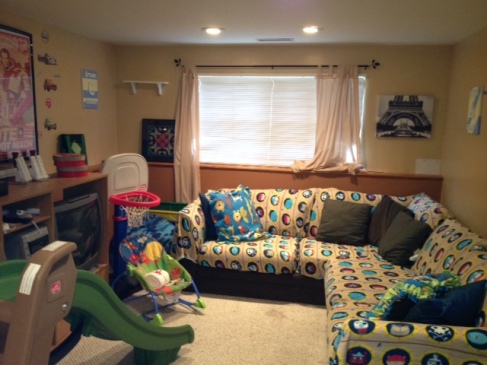In post #6, I talked a lot about Thing 1 and Thing 2’s “stuff”. The propensity to collect Stuff must be genetic. I like having stuff as well. More specifically, I love accessories for the home. My husband calls it my “nic-nac-ery”. This term came to be after I went on a consignment store and Goodwill binge. Every day I would have a new find. At first, I was so excited to tell him about the great find I got for only $2, $5, or $20 dollars (maybe more, but always below market value;) He didn’t really pay attention to it in the beginning. He would comment how nice that table looked in the entryway or wall-hanging I got for the office. Then he started looking at our bank account. All of those bargains were starting to add up. Of course I got defensive. Even if he was right, I had to validate the reasoning for way that new collection of vases for the bathroom were necessary.
Even if everything fit perfectly and worked out exactly as I had visualized in a space (I give myself about a 91%), I never stopped to ask myself if it was needed “right now”. About 85% of the time it was not. I have the mindset that if it is a great find, and a great value, then snap it up right then. My husband on the other hand may do a little more cost-benefit analysis than I would. Now if something is really a unique find, the exact thing that you needed for a particular purpose, or an outrageously low price for the value of the item, then whip out the checkbook. But, if it is something that you buy just because it was on sale,even if you didn’t need it, you are not gaining anything.
You may ask yourself, “Why is this person writing about decorating and telling me not to buy anything?” That is not the case. Again, this blog is not about decorating alone, it is about decorating in the context of your life. In decorating, you may not always be able to afford what you “want”, but you should prioritize for things that will improve you and your family’s life in some way. For example, you find some intricately carved, solid wood book ends that would go perfectly on your bookshelf. You have been complaining how you are tired of the books on the shelf always falling over. This find will satisfy your need. On the other hand, if you are looking at a beautiful jewelry box, but have no where to put it on your already full dresser, you may need to skip it. The aim is to dress your home to fit your life, and that includes how you choose to accessorize your home. Just think, passing on a few “nic-nacs” every now and then could leave you with a bigger budget for that custom made sectional you were dreaming of.
Enough pontificating, let’s continue our series…
7) Do accessorize out of children’s reach.
The danger zone for young children is anything withing about 45 inches of the floor, so make sure that your tchotchkes under that invisible line are safe and realitively sturdy.- a piece of driftwood, a grouping of seashells collected at the beach, moss-covered balls in a pewter bowl, chunky wooden candlesticks, iron picture frames with the glass removed, metal vases. Safeguard that heirloom vase, on the other hand, by placing it on a floating display ledge mounted high on the wall, atop a cabinet or armoire, or behind doors in a curio cabinet.

